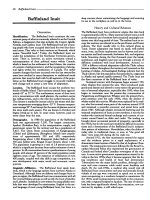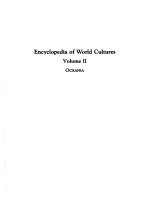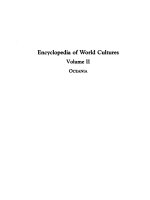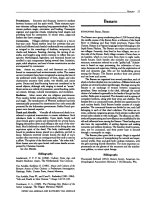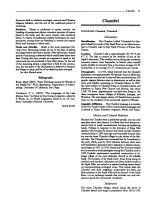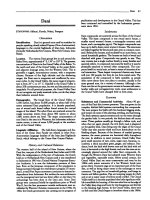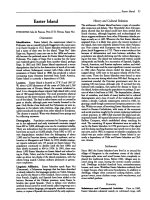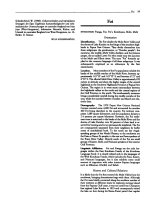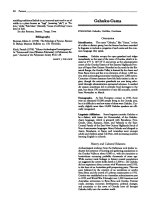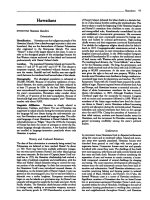Encyclopedia of World Cultures Volume 2 - Oceania - B pot
Bạn đang xem bản rút gọn của tài liệu. Xem và tải ngay bản đầy đủ của tài liệu tại đây (1.19 MB, 10 trang )
Banaro
21
Practitioners.
Sorcerers
and
shamans
(namer-o)
mediate
between
humans
and
the
spirit
world.
These
statuses
repre-
sent
visionary
callings
requiring
long
apprenticeships.
Practi-
tioners
perform
magic,
exorcisms,
and
healing.
Tesmaypits
organize
and
supervise
rituals,
employing
head
singers
and
providing
food
for
ceremonies.
In
recent
years,
cargo-cult
leaders
also
have
emerged.
Ceremonies.
Villages
celebrate
major
rituals
on
a
two-to
four-year
cycle.
Ritual
warfare
(and
the
activities
that
pre-
ceded
and
followed
each
battle)
traditionally
was
understood
as
integral
to
the
cosmology
of
dualism,
reciprocity,
and
checks
and
balances.
Feasting,
dancing,
the
carving
of
art-
works,
and
lengthy
song
cycles
continue
to
reflect
this
per-
spective.
Mythological,
legendary,
and
historical
heroes
are
extolled
in
epic
song-poems
lasting
several
days.
Initiation,
papis,
adult
adoption,
and
men's
house
construction
are
also
accompanied
by
ceremonies.
Arts.
Asmat
art,
music,
and
oral
literature
are
closely
bound
to
ceremonial
and
socioeconomic
cycles.
The
master
carvers
(wowipits)
have
been
recognized
as
among
the
best
of
the
preliterate
world.
Exuberance
of
form,
shape,
and
color
characterize
ancestor
(bis)
poles,
war
shields,
and
canoe
prows.
Drums
and
head-hunting
horns
are
considered
to
be
sacred
objects,
although
only
singing
is
viewed
as
'music."
Music
serves
as
a
vehicle
of
possession,
social
bonding,
politi-
cal
oratory,
therapy,
cultural
transmission,
and
recreation.
Medicine.
Most
curers
also
are
religious
practitioners.
They
employ
herbal
remedies
(including
tobacco),
sorcery,
and
magic.
The
introduction
of
Western
medicine
has
been
systematically
promoted
by
missionaries
but
only
erratically
promoted
by
the
Indonesian
government.
Earlier
Dutch
pro-
grams
were
deemed
superior.
Death
and
Afterlife.
Virtually
all
sickness
and
death
is
at-
tributed
to
spiritual
intervention
or
cosmic
imbalance.
Such
imbalance
leads
to
vulnerability.
Upon
death,
family
and
close
friends
grieve
openly
and
intensively
for
several
hours,
flinging
themselves
down
and
rolling
in
the
mud
of
the
river-
bank.
Mud
is
believed
to
mask
the
scent
of
the
living
from
the
capricious
spirit
of
the
dead.
The
body
traditionally
was
bound
in
pandanus
leaves,
placed
on
a
platform,
and
left
to
decay.
Relatives
retrieved
certain
bones;
the
skull
of
one's
mother
often
was
worn
on
a
string
around
the
neck
or
used
as
a
pillow.
The
spirits
of
the
dead
enter
safan,
"the
other
side."
Most
Asmat
now
rely
upon
burial,
with
some
deaths
accom-
panied
by
Christian
funerals.
See
also
Mimika
Bibliography
Amelsvoort,
V.
F.
P.
M.
(1964).
Culture,
Stone
Age,
and
Modern
Medicine.
Assen,
The
Netherlands:
Van
Gorcum.
Van
Arsdale,
Kathleen
0.
(1981).
Music
and
Culture
of
the
Bismam
Asmat
of
New
Guinea:
a
Preliminary
Investigation.
Hastings,
Nebr.:
Crosier
Press,
Asmat
Museum.
Van
Arsdale,
Peter
W.,
and
Carol
L
Radetsky
(1983-1984).
"Life
and
Death
in
New
Guinea."
Omega
14:155-169.
Voorhoeve,
C.
L.
(1965).
The
Flamingo
Bay
Dialect
of
the
Asmat
Language.
The
Hague:
Martinus
Nijhoff.
PETER
VAN
ARSDALE
AND
KATHLEEN
VAN
ARSDALE
Banaro
ETHNONYMS:
Banar,
Banara
The
Banaro
are
a
group
numbering
about
2,500
located
along
the
middle
course
of
the
Keram
River,
a
tributary
ofthe
Sepik
River
in
Madang
and
East
Sepik
provinces,
Papua
New
Guinea.
Banaro
is
a
Papuan
language
isolate
belonging
to
the
Sepik-Ramu
Phylum.
The
Banaro
are
today
concentrated
in
two
villages.
Formerly,
they
lived
in
four
villages,
two
on
ei-
ther
side
of
the
Keram.
Each
village
consists
of
from
three
to
six
hamlets,
which
in
turn
have from
three
to
eight
multi-
family
houses.
Each
hamlet
also
includes
one
communal
structure,
sometimes
referred
to
as
the
"goblin
hall."
Subsist-
ence
is
based
on
sago
processing,
the
cultivation
of
taro,
yams,
bananas
and
sugarcane,
fishing,
and
the
exploitation
of
wild
and
domestic
pigs.
Sibs
are
the
landholding
group
among
the
Banaro.
The
Banaro
produce
their
own
pottery
and
use
bows
and
arrows.
The
Banaro
are
organized
into
several
patricians,
each
of
which
is
further
divided
into
two
subclans.
Affiliated
with
each
subclan
are
several
localized
patrilineages.
Marriage
among
the
Banaro
is
an
exchange
of
women
between
exogamous
patricians.
Sister
exchange
is
the
ideal,
although
the
actual
choice
of
a
husband
is
generally
in
the
hands
of
the
girl
and
her
mother.
Bride-price
is
required.
The
domestic
unit
is
a
group
of
coresident
brothers,
along
with
their
wives
and
children.
The
families
live
in
a
communal
house,
divided
into
apartments
for
each
nuclear
family.
Each
Banaro
hamlet
consists
of
a
single
patrician.
The
communal
houses
are
divided
in
two,
each
half
belonging
to
each
of
that
clan's
subclans.
The
latter
are
to-
temic,
unilineal,
exogamous
groups.
Each
subclan
is
allied
with
several
other
subsibs
in
wife
exchanges.
The
alliances
are
effec-
tively
self-perpetuating
and
new
alliances
are
established
by
the
old
and
influential
men
among
the
Banaro.
These
leading
men
also
have
the
responsibility
of
settling
disputes
and
making
economic
and
military
decisions.
The
headmen
lead
by
persua-
sion,
not
by
command,
and
their
power
base
is
secured
through
a
monopoly
on
magic.
The
Banaro
place
great
faith
in
magic.
Magic
is
regarded
as
the
primary
means
of
manipulating
the
natural
and
super-
natural
worlds.
Boys
and
girls
both
undergo
initiation,
with
the
girls
marrying
shortly
thereafter.
The
most
important
su-
pernaturals
are
the
ghosts
of
the
ancestors
and
the
mischie-
vous
goblins,
or
minor
spirit
beings.
Bibliography
Thurnwald,
Richard
(1916).
Banaro
Society.
American
An-
thropological
Association
Memoirs
3
(4).Menasha,
Wis.
22
Bau.
Bau
ETHNONYMS:
Kubuna,
Mbau,
Tui
Kaba
Orientation
Identification.
The
name
'Bau"
was
originally
that
of
a
house
site
(yamu)
at
Kubuna
on
the
Wainibuka
River
in
the
interior
of
Viti
Levu,
the
main
island
of
Fiji,
but
today
'Bau"
usually
refers
to
the
small
offshore
islet,
home
of
the
para-
mount
chiefs,
and
'Kubuna"
to
those
who
claim
kinship
with
the
chiefly
families,
or
those
who
'go
with'
Bau
in
the
wider
politics
of
all
Fiji.
Location.
The
Kubuna
moved
down
the
Wainibuka
and
then
the
Wailevu
(Rewa)
river
valleys
to
occupy
the
north-
eastern
coast
of
the
Rewa
Delta
and
the
Kaba
Peninsula
be-
fore
making
a
home
for
their chiefs
on
the
small
islet
of
Bau,
at
17°58'
S,
178°37'
E.
This
islet
is
no
more
than
8
hectares
in
extent
and
15
meters
above
sea
level
at
the
highest
point.
Demography.
When
Bau
was
at
the
height
of
its
power,
the
population
on
the
islet
is
said
to
have
been
4,000.
The
paucity
of
available
data
permits
no
more
than
a
guess
as
to
the
number
of
its
supporters.
Mid-nineteenth-century
esti-
mates
varied
between
100,000
and
300,000
for
all
of
Fiji,
of
whom
perhaps
half
supported
Bau,
but
traditions
tell
of
disas-
trous
epidemics-associated
with
the
earlier
arrival
of
Euro-
peans-ravaging
the
population
by
as
much
as
40
percent.
The
1986
census
revealed
Fijians
in
the
provinces
that
'go
with"
Bau
totaling
175,000.
Linguitc
Affiliation.
The
language
is
one
of
300
'co-
mmunalects"
(dialects
largely
confined
to
one
community)
that
exist
among
the
contemporary
population
of
300,000
Fi-
jians.
In
the
early
nineteenth
century,
a
lingua
franca
based
on
the
communalects
of
Bau
and
Rewa
was
used
by
Fijians
from
different
parts
of the
islands
when
they
wished
to
com-
municate,
and
European
missionaries
chose
Bau
for
transla-
tion
of
the
Bible.
Europeanized
Bauan,
sometimes
also
called
Old
High
Bauan,
has
now
become
the
basis
for
Standard
Fi-
jian,
which
is
in
the
Oceanic
Branch
of
Austronesian
languages.
History
and
Cultural
Relations
Although
Fiji
has
been
inhabited
for
at
least
3,500
years,
much
intervening
history
has
been
lost
to
memory.
AU
of
the
great
chiefdoms
of
eastern
Vid
Levu
trace
their
founding
an.
cestors
to
the
Nakauvadra
Mountains
near
the
north
coast,
but
existing
genealogical
information
cannot
be
held
to
relate
to
earlier
than
the
sixteenth
century.
The
Bau
had
two
great
chiefly
lines,
that
of
the
Rokotui
Bau,
the
sacred
chiefs,
and
the
Vunivalu,
war
chiefs
and
executive
chiefs.
After
moving
to
the
islet,
the
Bau
began
extending
their
influence.
The
Vunivalu
Naulivou
exploited
musket-bearing
European
beachcombers
to
such
effect
that
at
the
time
of
his
death
in
1829,
Bau
seemed
well
on
the
way
to
establishing
a
Fiji-wide
hegemony.
Rebellion
in
1832
halted
this
inexorable
rise,
and
as
the
century
advanced,
relationships
between
Bau
and
other
chiefdoms,
and
between
Fijians
and
Europeans,
be-
came
increasingly
complex.
Missionaries
arrived
at
Bau
in
1839.
Their
progress
was
limited
during
the
early
stages
of
the
war
between
Bau
and
Rewa,
which
dominated
Fiji's
politics
during
the
middle
years
of
the
century,
but
in
1854,
the
Vuni-
valu
Cakobau
converted
to
Christianity,
and
the
climactic
battle
of
Kaba,
in
1855,
took
on
the
character
of
a
struggle
be-
tween
pagan
and
Christian
power
in
Fiji.
Thereafter,
Euro-
pean
influence
increased.
Fiji
was
ceded
to
Great
Britain
in
1874,
with
Cakobau
signing
the
deed
as
King
of
Fiji.
The
British
colonial
administration
adopted
a
fairly
benign
pater-
nalism
towards
all
Fijians.
Alienation
of
land
was
stopped,
but
evolution
of
Fijian
society
and
adaptation
to
change
were
severely
limited.
The
old
chiefdoms
such
as
Bau
became
rela-
tively
insignificant,
although
some
of
the
chiefs
were
involved
in
administration.
With
independence
in
1970,
and
even
more
so
after
the
military
coups
of
1987,
however,
the
chiefly
confederations
have
once
again
come
to
the
fore.
Settlements
Although
the
focus
of
the
chiefdom
was
Bau
Island,
there
were
many
tributary
towns
and
villages,
each
with
their
own
territory
up
and
down
the
Tailevu
coast,
along
the
north
coast
of
the
delta,
and
on
nearby
islands
in
the
Koro
Sea.
During
the
period
of
greatest
turbulence,
villages
were
elabo-
rately
defended.
Those
in
the
swamplands
of
the
delta,
in
par-
ticular,
were
surrounded
with
impenetrable
barriers
of
fences
and
ditches
strengthened
with
concealed
and
upraised
spikes.
Special
structures
included
the
temple
to
the
ancestral
god
of
the
paramount
chiefs,
the
house
sites
of
the
most
important
families,
which
were
built
on
rock-stepped
platforms,
and
the
stone-bordered
canoe
docks,
representing
political
suprem-
acy.
In
order
to
provide
more
land,
terraces
were
leveled
and
foreshore
reclaimed,
and
a
bridge
was
built
to
connect
the
islet
with
the
mainland
more
than
a
kilometer
away.
During
the
time
of
friendship
with
Rewa,
a
2-kilometer
canal
was
dug
linking
adjacent
channels
of
the
great
river
to
provide
easier
access
between
the
two
centers
of
power.
Economy
Subsistence
and
Commercial
Activities.
Bauan
Fijians
were
subsistence
horticulturists,
raising
root
crops
such
as
taro
and
cassava
on
a
swidden
basis
on
the
drier
Tailevu
coastal
lands,
but
planting
swamp
taro
in
carefully
mounded
and
ditched
plots
in
the
Rewa
Delta.
Fishing
and
collecting
the
resources
of
mangroves
and
the
nearby
reefs
provided
im-
portant
additional
food.
Trading
with
Europeans
began
when
the
latter
discovered
stands
of
sandalwood
on
the
northern
island
of
Vanua
Levu
in
the
first
decade
of
the
nineteenth
century,
and
it
greatly
intensified
when
the
technology
associ-
ated
with
the
drying
of
sea
slugs
(trepang)
was
brought
to
Fiji
from
China
in
the
1820s.
The
chiefs
of
Bau
deployed
their
supporters
in
order
to
acquire
the
cash
they
needed
to
buy
guns,
ammunition,
and,
in
the
case
of
the
Vunivalu
Cakobau
of
Bau,
a
schooner
for
his
personal
use.
Today,
60
percent
of
the
total
population
lives
in
villages,
largely
still
with
a
sub-
sistence
economy
and
the
continued
obligations
of
commu-
nal
life,
but
rural-urban
drift
is
creating
problems.
More
Fiji-
ans
work
for
wages
and
seek
employment
in
towns,
resulting
in
a
lack
of
housing,
employment,
and
education
opportuni-
ties
and
a
weakening
of
the
resources
of
the
villages.
Since
the
coups
of
1987,
the
Fijian-dominated
government
has
sought
to
redress
imbalances
that
it
perceives
between
Fijians
and
In-
dians,
originally
brought
to
the
country
by
the
colonial
ad-
Bau
23
ministration
in
1878
to
work
in
the
plantation
sugar
industry
that
eventually
became
the
basis
of
the
colonial
economy.
Industrial
Arts.
Traditional
crafts
of
Fiji
included
the
making
of
pots,
woven
mats,
and
fine
bark
cloth
by
the
women,
and,
by
the
men,
the
carving
of
whalebone
ivory
(sometimes
inlaid
with
pearl
shell)
and
a
wide
variety
of
wooden
artifacts,
including
spears
and
clubs,
bowls
for
the
ceremonial
drinking
of
kava,
and
the
great
seagoing
double-
hulled
canoes
that
permitted
speedy
passage
between
the
is-
lands
of
Fiji
and
to
Samoa
and
Tonga
to
the
east.
Trade.
Bauan
power
rested
on
the
ability
to
maintain
a
wide
network
of
tributary
relationships
that
involved
the
sup-
plying
to
it
of
all
the
resources
of
the
land
and
sea,
including
the
crafts
mentioned
above.
Europeans
were
integrated
into
the
system
whenever
possible,
particularly
in
the
first
half
of
the
nineteenth
century.
Division
of
Labor.
In
traditional
times,
family
units
spread
widely
over
the
land,
cultivating
and
collecting.
The
division
of
labor
was
according
to
both
age
and
sex.
Men
produced
a
far
greater
proportion
of
the
family's
food,
for
agriculture
was
and
remains
the
domain
of
men.
Young
girls
might
collect
taro
leaves,
but
otherwise
they
would
not
go
to
the
gardens.
Fishing
by
line
or
net
and
the
collection
of
molluscs
and
other
products
of
the
reef
are
women's
work,
as
is
the
fetching
of
water,
most
cooking,
and
the
care
of
house
and
children.
Young
children
of
8
or
9
might
help
their
parents,
but
lack
of
responsibility
usually
lasts
until
14
or
so.
The
heavier
tasks
fall
on
the
younger
men
and
women.
The
domestic
seniority
system
serves
to
organize
household
production;
this
arrange-
ment
was
especially
true
of
the
traditional
extended
family.
Land
Tenure.
Land
was
held
by
the
"family,"
which
was
defined
more
or
less
inclusively
in
different
parts
of
Fiji.
Dur-
ing
the
period
of
its
rise
to
power,
Bau
struggled
with
Rewa
for
control
of
the
delta
and
sought
to
impose
a
tributary
relation-
ship
on
those
they
conquered.
The
colonial
government
de-
fined
principles
of
land
tenure
retrospectively,
creating
ho-
mogeneity
in
place
of
a
system
built
on
dynamism
and
change.
They
based
their
system
at
least
in
part
on
Bauan
norms.
Kinship
Kin
Groups
and
Descent.
Fijian
society
is
organized
into
a
hierarchy
of
kinship
groups
of
increasing
orders
of
inclusive-
ness.
At
Bau,
the
chiefly
yavusa
was
divided
into
four
patricIans:
the
two
chiefly
mataqali,
a
warrior
clan,
and
a
her-
ald
clan
divided
into
two
subclans
associated
with
each
of
the
chiefly
lines.
With
the
rise
to
political
importance
of
the
chiefly
confederations
since
the
1987
coups,
clan
relation-
ships
at
the
individual
level
are
becoming
more
important
once
again.
Kinship
Terminology.
The
system
is
of
the
Iroquois
type,
with
some
special
features.
There
is
the
usual
sharp
distinc-
tion
between
cross
and
parallel
relatives,
but
bifurcate
merg-
ing
occurs
in
all
but
the
second
descending
generation,
in
which
kinship
reckoning
is
simply
generational.
Among
the
chiefly
families
of
Bau,
the
vasu
relationship,
between
ego
and
mother's
brother,
was
used
to
cement
ties
with
other
chiefdoms.
The
vasu
was
able
to
make
particular
demands
on
the
material
wealth
of
his
maternal
uncle's
kin
group,
fre-
quently
doing
so
in
the
interests
of
his
own
chiefdom.
Marriage
and
Family
Marriage.
Traditionally,
the
preferred
marriage
alliance
was
between
cross
cousins;
marriage
between
tribes
was
possi-
ble
only
after
formal
request.
Nonsororal
polygyny
was
prac-
ticed,
and
a
man's
status
was
defined
by
the
number
of
his
wives.
The
great
chiefs
married
many
times,
usually
in
the
in-
terests
of
extending
political
power.
This
meant
that
all
of
the
chiefly
families
of
Fiji
were
closely
related,
often
many
times
over
in
succeeding
generations.
In
such
situations,
the
status
of
the
first
wife
was
distinctly
superior.
The
title
of
the
princi-
pal
wife
of
the
Rokotui
Bau
was
'Radi
ni
Bau,"
and
his
sec-
ond
wife
was
tided
'Radi
Kaba."
The
principal
wife
of
the
Vunivalu
was
called
'Radi
Levuka."
Marriage
ceremonial
was
more
or
less
elaborate
depending
on
the
rank
of
the
partici-
pants.
Patrilocal
residence
was
the
norm,
and
divorce
could
be
effected
easily
by
either
party.
Domestic
Unit.
The
traditional
extended
family
consisted
of
several
married
pairs
and
their
children,
inhabiting
sepa-
rate
dwellings
but
sharing
and
cooperating
in
one
cook
house.
Typically,
men
of
the
family
would
be
closely
related
to
the
paternal
line,
but
a
daughter
and
her
husband
might
also
belong.
The
senior
male
would
use
the
ancestral
house
site
(yavu).
Inheritance.
Dwelling
houses
are
allocated
by
the
family
head
and
remain
under
his
control,
as
do
garden
plots
and
other
family
property
such
as
canoes.
At
his
death,
his
surviv-
ing
senior
sibling
determines
the
disposition
of
the
house
if
the
deceased
has
no
mature
sons.
In
the
case
of
the
great
chiefs,
the
council
of
the
whole
tribe
(yavusa)
would
deter-
mine
succession
and
with
it
all
rights
to
property.
Socialization.
The
rigor
and
principles
of
family
ranking
are
a
microcosm
of
larger
kin
groups
and
communities.
Chil-
dren
are
subordinate
to
their
parents,
but
they
are
also
ranked
relative
to
each
other
by
birth
order.
Aboriginally,
they
were
ranked
first
by
order
of
marriage
of
their
mothers
and
then
be-
tween
full
siblings
by
birth
order.
The
first
child
(ulumatua)
has
a
special
status.
Obedience
and
respect
are
demanded
of
the
child
by
the
father,
after
infancy
the
child
is
constantly
taking
orders.
Punishment
by
the
father
is
the
main
discipli-
nary
mechanism,
and
the
mother
is
more
indulgent
than
the
father,
particularly
towards
boys
and
young
men
of
the
family.
Sociopolitical
Organization
Social
Organizato.
The
social
organization
of
the
chiefdom
was
extraordinarly
complex,
with
all
aspects
of
its
existence
ringed
with
ceremony.
Each
individual
identified
with
a
hierarchy
of
increasingly
inclusive
groups:
extended
family,
subclan,
clan
(yavusa),
federation
of
clans
(vanua),
and
political
confederation
(matanitu).
The
focus
of
the
chiefdom
was
the
chiefly
clan,
which
was
supported
and
de-
fended
by
two
groups
of
hereditary
fishers,
who
also
had
the
role
of
defending
the
chiefs
from
attack
by
land
or
sea.
Political
Organization.
As
head
of
the
political
confedera-
tion,
the
chiefly
clan
of
Bau
sought
to
maintain
a
network
of
tributary
relationships
through
its
subclans.
This
arrangement
implied
a
degree
of
political
instability,
and,
indeed,
the
history
of
the
first
half
of
the
nineteenth
century
was
one
of
a
ceaseless
struggle
for
power.
Warrior
subclans
were
spread
as
a
shield
along
the
north
coast
of
the
Rewa
Delta
and
at
the
base
of
the
24
Bau
Kaba
Peninsula,
separating
Bau
and
Rewa.
More
distant
ties
were
based
on
acknowledged
ancestral
kin
relationships.
As
such,
they
required
to
be
constantly
reinforced
within
the
con-
temporary
play
of
political
forces.
The
colonial
administrative
system
and
that
of
the
immediate
postindependence
period
di-
vided
the
old
chiefdom
of
Bau
between
several
new
adminis-
trative
units,
but
in
postcoup
Fiji
the
chiefly
confederations
are
again
assuming
political
significance.
Social
Control.
Reflecting
a
preference
for
avoiding
direct
confrontation,
gossip,
ostracism,
and
social
withdrawal
have
always
been
important
forms
of
social
control.
Fear
of
divine
retribution
was
and
remains
a
powerful
sanction
at
both
the
individual
and
the
community
level.
The
colonial
govern-
ment
made
Fijians
subject
to
its
judicial
system,
but
since
the
1987
coups
there
has
been
an
attempt
to
reincorporate
tradi-
tional
principles
into
the
legal
system.
Conflict.
There
were
ceremonial
ways
of
asking
forgiveness
where
there
was
a
wish
for
reconciliation,
ending
with
the
drinking
of
kava.
The
vasu
could
also
defuse
potential
con-
flict,
being
able
effectively
to
represent
the
female
side
in
a
patrilineal
society.
Religion
and
Expressive
Culture
Religious
Beliefs.
In
traditional
times,
religious
belief
cen-
tered
on
the
deified
founders
of
clans,
frequently
worshipped
in
animal
form.
In
addition,
each
group
had
its
own
set
of
ani-
mal
and
plant
totems,
deemed
to
be
inhabited
by
ancestral
spirits.
The
missionaries
succeeded
in
driving
ancient
beliefs
underground,
but
they
surfaced
several
times
at
the
end
of
the
nineteenth
century,
usually
in
the
form
of
atavistic
cults
as
vehicles
for
anticolonial
opposition.
Today,
Methodism
claims
the
support
of
most
Fijians,
although
there
is
an
im-
portant
Roman
Catholic
minority.
Religious
Practitioners.
Traditionally,
priests
formed
he-
reditary
dans,
exercising
important
divinatory
and
healing
roles
and
acting
as
the
voice
of
the
ancestral
gods.
Ceremonies.
These
were
mainly
associated
with
life
cycles
and
with
intergroup
relationships.
In
ancient
times,
there
was
a
ceremony
of
first
fruits,
when
the
various
tributaries
of
Bau
brought
offerings
of
food
to
the
Rokotui
Bau
and
later
to
the
Vunivalu,
these
usually
being
in
the
form
of
delicacies
for
which
particular
groups
were
well
known.
This
ceremony
was
conducted
according
to
the
traditional
calendar.
Arts.
Singing
and
chanting,
dancing,
and
joke
telling
were
the
traditional
arts.
The
sexes
never
danced
together
and
had
quite
different
dances.
Both
danced
standing
and
sitting.
The
women
used
delicate
hand
movements,
while
the
men
often
danced
with
fan
and
spear
or
club,
or
with
sticks.
Medicine.
Disease
was
understood
as
deriving
from
malev-
olence
of
the
spirits,
particularly
after
the
violation
of
taboos.
Women
collected
and
compounded
herbal
cures,
while
men
applied
them-a
reflection
of
the
belief
that
men
possessed
heavenly
power
(mana)
whereas
the
strength
of
women
came
from
the
earth.
Massage
was
also
an
important
healing
tech-
nique,
but
women
massaged
only
women,
and
men
only
men.
Death
and
Afterlife.
The
ceremony
associated
with
death
was
extremely
elaborate,
particularly
when
the
status
of
the
deceased
was
high,
reflecting
its
importance
in
traditional
be-
lief.
Tributary
groups
would
come
to
pay
homage
to
the
corpse
and
to
the
bereaved
family,
cementing
ties
in
the
proc-
ess.
After
the
burial
of
a
high
chief,
a
taboo
was
laid
on
the
waters
around
Bau,
and
the
women,
having
kept
vigil
over
the
corpse
for
four
to
ten
days,
would
cut
their
hair,
only
after
100
nights
of
mourning
would
the
taboos
be
lifted.
Wives
were
strangled
to
go
with
their
husbands
into
the
spirit
world,
for
on
the
way
lurked
Ravuyalo,
who
killed
the
spirits
of
those
who
failed
to
accompany
their
spouses.
The
unmarried
were
buried
with
a
club
for
their
own
defense.
See
also
Lau
Bibliography
Nayacakalou,
R
R.
(1975).
Leadership
in
Fiji.
Melbourne:
Oxford
University
Press.
Ravuvu,
Asesela
D.
(1988).
Development
or
Dependence:
The
Pattern
of
Change
in
a
Fijian
Village.
Suva,
Fiji:
University
of
the
South
Pacific.
Thomson,
Basil
(1908).
The
Fijians:
A
Study
of
the
Decay
of
Custom.
London:
Heinemann.
Reprint.
1968.
London:
Dawsons.
Williams,
Thomas
(1858).
Fiji
and
the
Fijians.
Vol.
1,
The
Is-
lands
and
Their
Inhabitants.
London:
Alexander
Heylin.
Re-
print.
1982.
Suva:
Fiji
Museum.
DAVID
ROUTLEDGE
Belau
ETHNOMYMS:
Palau,
Pelew
Orientation
Identification.
Hearing
the
word
beluu,
"village
home-
land",
early
British
explorers
of
the
western
Pacific
mistakenly
referred
to
the
Belau
Islands
as
"Pelew";
the
spelling
'Palau"
became
standardized
in
nineteenth-century
German
scien-
tific
writings.
The
form
'Belau"
more
accurately
reflects
con-
temporary
pronunciation
and
has
become
a
symbol
of
na-
tional
unity.
Location.
Belau,
an
archipelago
in
the
western
Pacific
Ocean,
is
located
between
6°
and
8"
N
and
134°
and
135°
E.
The
islands
form
the
westernmost
group
of
the
Caroline
Is-
lands
of
Micronesia.
Belau
includes
over
200
geologically
and
ecologically
diverse
islands;
the
largest,
Babeldaob,
is
a
vol-
canic
island
of
362
square
kilometers.
Other
island
types
in-
clude
high
limestone
and
platform
limestone
islands,
small
reef
islands,
and
one
true
atoll.
A
coral
reef
encircling
most
of
the
archipelago
creates
lagoons
rich
in
marine
resources
and
permits
relatively
smooth
intervillage
sailing.
The
climate
is
tropical,
with
constantly
high
humidity,
a
mean
temperature
of
27°
C,
and
rainfall
ranging
from
320
centimeters
per
year
in
the
south
to
425
centimeters
per
year
on
Babeldaob.
A
Belau
25
yearly
wind
shift
from
westerly
monsoons
in
the
summer
to
easterly
trades
in
the
winter
is
interrupted
only
by
typhoons,
which
periodically
destroy
homes,
harbors,
and
farms.
Demography.
The
population
in
1988
was
approximately
14,000,
about
half
of
whom
live
on
the
island
of
Koror.
Esti-
mates
of
precontact
population
range
from
20,000
to
40,000.
From
the
late
eighteenth
century
on
Belauans
were
subject
to
decimation
by
introduced
diseases
and
by
the
intensification
of
warfare
caused
by
imported
firearms.
The
Japanese
began
a
massive
colonial
resettlement
program
in
the
1930s,
resulting
in
a
foreign
population
of
over
24,000
in
Koror
by
1940.
Since
World
War
II
the
local
population
has
risen
dramati-
cally,
and
many
Belauans
have
moved
to
Guam,
Hawaii,
and
California.
linguistic
Affiliation.
Belauan,
an
Austronesian
lan-
guage,
is
spoken
uniformly
throughout
the
archipelago;
only
minor
differences
in
accent
and
idiomatic
expressions
indi-
cate
a
speaker's
home
village.
Most
Belauans
over
the
age
of
fifty
are
also
fluent
in
Japanese,
and
those
younger
than
fifty
speak
English.
Belauan
is
referred
to
as
a
Nonnuclear
Micro-
nesian
language,
since
it
has
closer
genetic
affinity
with
lan-
guages
spoken
in
eastern
Indonesia,
Taiwan,
and
the
Philip-
pines
than
with
those
spoken
in
the
rest
of
Micronesia.
The
language
is
noted
for
its
complex
system
of
verbal
inflections,
the
presence
of
a
phonemic
glottal
stop,
and
an
archaic
set
of
lexical
items
found
in
chants
and
myths.
History
and
Cultural
Relations
The
archipelago
was
discovered
more
than
2,000
years
ago
by
Austronesian
voyagers
sailing
from
insular
Southeast
Asia.
These
early
settlers
occupied
both
low-ling
islands,
where
fishing
was
the
primary
subsistence
activity,
and
high
vol-
canic
and
limestone
islands,
where
extensive
taro
cultivation
was
possible.
Perhaps
as
late
as
the
twelfth
century
A.D.,
the
is-
landers
constructed
monumental
terraced
earthworks
and
built
inland
villages
on
elaborate
stone
foundations.
There
is
a
strong
possibility
that
prior
to
European
contact
Belau
had
interaction
with
the
Chinese,
whose
ships
could
have
been
the
source
of
the
ceramic
and
glass
beads
still
functioning
as
exchange
valuables.
Sir
Francis
Drake
visited
briefly
in
1579;
extensive
relations
between
Belau
and
the
West
began
in
1783
when
the
East
India
Company
packet
Antelope
wrecked
on
the
reef.
The
islands
have
been
subject
to
successive
claims
by
colonial
powers:
Spain
(1885-1899),
Germany
(1899-1914),
and
Japan
(1914-1944).
In
1947
Belau
be-
came
part
of
the
Trust
Territory
of
the
Pacific
Islands,
a
United
Nations
'strategic
trusteeship"
under
the
administra-
tion
of
the
United
States.
Constitutional
self-government
was
proclaimed
in
1981
when
the
Republic
of
Belau
seated
its
first
government,
while
the
islands
continued
to
be
subject
to
the
trusteeship.
After
decades
of
bitter
factional
and
legal
dis-
putes,
Belau
is
currently
negotiating
a
Compact
of
Free
Asso-
ciation
with
the
United
States.
The
first
president
of
Belau,
Haruo
Remeliik,
was
assassinated
in
1985;
the
second
presi-
dent,
Lazarus
Sahii,
died
of
gunshot
wounds
in
1988.
Settlements
There
are
two
types
of
settlements,
relatively
'rural"
villages
located
on
Babeldaob,
Ngcheangel,
Beliliou,
and
Ngeeur,
and
the
relatively
'urban"
town
of
Koror.
Starting
in
the
nine-
teenth
century,
Belauans
abandoned
their
inland
villages
and
built
new
settlements
closer
to
coastal
harbors
and
alluvial
streams.
Koror
was
the
center
for
nineteenth-century
colonial
trading
operations,
was
later
the
headquarters
of
the
Japanese-mandated
Pacific
islands,
and
is
presently
the
home
of
most
government
offices,
schools,
retail
shops,
restaurants,
and
tourist
facilities.
Many
Belauans
maintain
dual
resi-
dences
in
Koror
and
in
their
home
villages,
and
some
even
commute
by
motorboat
on
a
daily
basis.
Formerly,
villages
consisted
of
residential
and
meeting
houses
constructed
of
dosely
joined
lumber,
with
thatched
roofs,
and
elevated
barm
boo
floors;
today,
tin
roofs
and
concrete
block
foundations
are
favored
in
new
construction.
In
many
places
on
Babel-
daob
one
can
still
detect
the
typical
village
layout,
with
meet-
ing
houses
located
on
a
central
paved
square,
canoe
houses
and
men's
clubhouses
standing
near
the
shore
or
river,
and
residential
houses
fanning
out
along
elevated
stone
walkways.
Economy
Subsistence
and
Commercial
AcDivities.
Fish
and
taro
have
long
been
the
staple
foods
of
Belau.
Fishing
by
spear
gun,
line,
hand
net,
and
trap
is
carried
out
in
the
coastal
la,
goons;
high-powered
speedboats
are
used
for
trawling
outside
the
reef.
The
catch
is
pooled
by
local
cooperative
associations
for
retail
sale
in
Koror.
In
preparation
for
funerals
and
festi-
vals,
men
work
the
lagoon
with
huge
nets.
Women
take
pride
in
taro
cultivation
on
'dry"
upland
slopes
and
in
'wet"
irri-
gated
swamps;
the
backbreaking
labor
required
has
led
many
younger
women
to
substitute
cassava
and
imported
rice.
Young
men
raise
pigs
for
slaughter
at
ceremonial
events.
In-
creasingly
vast
amounts
of
imported
commercial
goods
are
re.
placing
locally
produced
items.
In
Koror
the
government
is
the
largest
employer,
and
little
locally
owned
industry
has
flourished.
Belau
is
completely
dependent
upon
U.S.
govern-
ment
funds
and
upon
payments
from
other
countries
for
ac-
cess
to
Beau's
marine,
strategic,
and
recreational
resources.
Industrial
Arts.
Skills
such
as
wood
carving,
meeting-
house
construction,
and
tortoiseshell-ornament
production
are
becoming
rare;
basket
weaving,
however,
is
widely
prac-
ticed
by
women.
Most
able-bodied
men
are
expert
fishermen,
and
individuals
win
renown
by
developing
specialized
tech-
niques
and
by
possessing
expert
knowledge
of
tides
and
spawning
cydes.
Young
people
strive
to
obtain
advanced
edu-
cational
and
business
training
at
stateside
schools.
In
the
vil-
lages,
wage
earners
include
schoolteachers,
nurses,
magis-
trates,
land
registrars,
and
religious
officials.
Trade.
Interdistrict
trade
in
the
traditional
context
in-
volved
not
only
daily
necessities
such
as
lamp
oil,
pottery,
wooden
implements,
palm
syrup,
and
canoe
sails
but
also
spe-
cialized
prestige
goods
such
as
turmeric
powder,
tortoiseshell
ornaments,
women's
shirts,
red-ocher
dye,
and
dugong
brace-
lets.
In
the
nineteenth
century,
European
settlers
established
trading
centers
for
the
commercial
extraction
of
trepang,
pearl
shell,
and
copra.
Now,
a few
families
in
each
village
run
small
retail
stores.
A
complex
system
of
social
exchange,
in-
volving
the
presentation
of
food
and
service
in
return
for
cash
and
valuables
across
the
affinal
bond,
is
the
principal
focus
of
daily
economic
life.
U.S.
currency
is
used
in
financial
transac-
tions;
Belauan
valuables
supplement
cash
in
customary
exchanges.
26
Belau
Division
of
labor.
The
most
important
division
of
labor
is
between
fishing,
emblematic
of
male
virtue,
and
taro
cultiva-
tion,
symbolic
of
female
productiveness.
This
split
parallels
the
duel
system
of
exchange
values,
women
using
locally
pro-
duced
hammered
turtleshell
trays
and
men
using
beads
and
cylinders
of
foreign
origin.
Women
take
charge
of
domestic
activities,
such
as
food
preparation,
child
care,
and
laundry,
and
they
also
carry
heavy
responsibility
in
selecting
holders
of
male
and
female
chiefly
tides.
Land
Tenure.
Prior
to
changes
imposed
by
colonial
pow-
ers,
land
was
either
'public
land
of
the
village"
(chutem
buai
er
a
beluu),
subject
to
the
local
chiefly
council,
or
"land
of
the
principal
houses"
(chetemel
a
kebtfil),
controlled
by
chiefly
titleholders
and
senior
matrilineal
relatives.
Residential
sites
and
taro
patches
were
assigned
to
affiliated
family
segments
rather
than
being
passed
down
to
offspring.
These
lands
re-
verted
to
chiefly
control
for
redistribution.
German
officials
instituted
patrilineal
land
inheritance
and
encouraged
nu-
clear
families
to
move
their
houses
and
to
plant
coconut
trees
on
unused
village
land.
Today,
land
is
divided
into
'public
land"
controlled
by
the
national
government,
'clan
land"
controlled
by
chiefly
houses,
"village
land"
governed
by
vil-
lage
councils,
and
private
property
owned
in
fee
simple.
The
national
government
is
forbidden
by
the
constitution
to
use
eminent
domain
for
the
purpose
of
helping
a
foreign
country.
Kinship
Kin
Groups
and
Decent.
The
basic
kin
unit
is
the
'house"
(blai),
which
is
composed
of
individuals
linked
by
strong
matrilateral
bonds
(oche.l,
or
'offspring
of
women")
and
of
individuals
associated
by
weaker
patrilateral
ties
(ule-
chelU,
or
"offspring
of
men").
Each
house
controls
a
residen-
tial
site,
taro
patches,
a
chiefly
title,
exchange
valuables,
and
ceremonial
prerogatives.
Houses
form
wider
affiliative
net-
works
(kebliil)
both
within
the
village
and
between
villages,
which
function
to
channel
social
cooperation,
exchange,
and
inheritance.
The
complexity
of
Belauan
kinship
lies
in
the
lateral
breadth
of
relationships
rather
than
in
the
depth
of
re-
membered
genealogies.
Kinship
Terminology.
Distinctive
characteristics
of
the
system
of
kin
terms
include:
the
overriding
of
generation
(off-
spring
of
women
label
offspring
of
men
as
"children");
the
im-
portance
of
sibling
rank
reflected
in
senior
and
junior
terms
for
both
males
and
females;
a
reciprocal
term
for
cross-sex
siblings
signaling
the
solidarity
of
the
brother-sister
pair;
the
existence
of
a
special
term
for
mother's
brother;
and
the
gen-
eralization
of
the
respectful
kin
terms
"mother"
and
'father"
in
polite
address
to
all
elders.
With
respect
to
the
genera-
tional
stratification
of
sibling
and
cousin
terms,
the
system
could
be
labeled
Hawaiian;
with
respect
to
the
skewing
of
generations
due
to
the
importance
of
matrilineal
ties,
it
could
be
labeled
Crow.
Titleholders
are
never
addressed
by
their
personal
names.
Marriage
and
Family
Marriage.
Marriage
is
fundamentally
an
economic
institu-
tion.
Traditionally,
high-ranking
women
were
prohibited
from
"falling,"
that
is,
marrying
a
man
of
lower
rank.
The
pro-
hibition
was
based
on
economic
considerations-if
the
hus-
band
were
of
low
rank
his
relatives
would
be
unable
to
make
a
sufficient
financial
contribution
and
the
couple's
male
child
would
lack
the
financial
assets
needed
to
maintain
his
chiefly
authority.
Today,
individuals
are
free
to
select
spouses,
but
social
rank
and
wealth
are
critical
considerations.
Fragile
marital
ties
are
subordinate
to
enduring
kinship
ties:
while
the
former
are
severed
at
death
or
divorce,
the
latter
are
a
"bridge
forever."
High-ranking
individuals
tend
to
marry
out-
side
of the
village,
and
there
is
still
considerable
rank
endo-
gamy.
Newly
married
couples
establish
independent
houses
on
land
near
the
husband's
father's
house;
men
who
receive
a
chiefly
tide
can
move
back
to
their
matrilineal
home.
Divorce
is
frequent
and
remarriage
is
the
norm.
Domestic
Unit.
The
residential
family
(ongalek)
often
in-
cludes
grandparents
and
other
extended
kin.
Adoption
of
children
within
the
network
of
kin
is
common.
Inheritance.
Property
belonging
to
the
house
is
controlled
by
senior
"offspring
of
women"
members,
who
select
the
heirs
to
land
and
valuables.
Much
private
property
passes
in
the
pa-
triline.
Women
give
turtleshell
heirlooms
to
their
daughters.
Socializaton.
Mothers
play
a
greater
role
in
child
raising
than
fathers;
children
have
a
more
relaxed,
affectionate
rela-
tionship
with
fathers
than
with
mother's
brothers.
Older
sib-
lings
take
on
child-care
responsibilities.
Young
men's
clubs
act
as
powerful
peer
reference
groups.
Sociopolitical
Organization
Social
Organization.
The
principles
of
democratic
egali-
tarianism
and
inherited
hierarchical
rank
conflict
in
contem-
porary
Belau.
Rank
pertains to
relations
between
siblings,
be-
tween
houses
in
a
village,
between
titles
in
a
political
council,
and
between
villages
within
the
state.
According
to
myth,
four
villages
were
regarded
as
preeminent:
Imeiong,
Mele-
keok,
Imeliik,
and
Koror.
Financial
wealth,
elected
political
office,
and
esoteric
knowledge
are
other
sources
of
social
power.
Political
Organization.
Prior
to
the
indoctrination
into
democratic
values
and
practices,
Belau
was
governed
by
chiefs,
whose
titles
were
ranked
according
to
the
social
hierarchy
of
local
land
parcels.
Called
duz,
the
word
for
'coconut
palm
frond,"
tides
possess
sacredness
and
demand
respect
apart
from
the
person
who
carries
the
tide.
The
highest
titleholders
from
Melekeok
village
(the
Reklai
tide)
and
Koror
village
(the
Ibedul
tide)
have
emerged
as
"paramount
chiefs"
of
the
archi-
pelago.
Today,
Belau
is
a
self-governing
constitutional
repub-
lic,
headed
by
an
elected
president
and
a
national
legislature.
Traditional
chiefs
play
an
advisory
role
at
the
national
leveL
Each
state
is
headed
by
an
elected
governor
and
sends
two
sen-
ators
to
the
national
legislature.
At
the
village
level,
a
council
of
chiefs
parallels
a
council
of
elected
officials,
headed
by
a
magistrate.
The
central
role
of
multivillage
confederacies,
once
factions
for
intervillage
warfare,
has
vanished.
Social
ControL
Traditional
sanctions,
including
fines
and
banishment,
applied
by
the
local
council
of
chiefs
are
supple-
mented
by
the
legislated
civil
code,
which
in
turn
is
subject
to
the
laws
of
the
Trust
Territory.
Conflict.
In
the
absence
of
interdistrict
political
councils
in
the
precolonial
period,
intervillage
hostility
functioned
as
a
primary
means
of
political
integration
and
as
a
mechanism
for
the
financial
enrichment
of
chiefs.
Warfare
took
the
form
Bikini
27
of
either
swift
head-hunting
raids
or
massive
sieges
aimed
at
the
devastation
of
the
enemy
village.
Also,
rivalry
among
chiefs
and
competition
over
tide
inheritance
created
powerful
motives
for
political
assassination.
Religion
and
Expressive
Culture
Religots
Beliefs.
Belau
has
been
heavily
missionized
by
Catholics,
Seventh-Day
Adventists,
and
Mormons.
A
nativ-
istic
movement,
Modekngei,
or
"Let
Us
Go
Forth
Together,"
is
a
powerful
religious
and
educational
force.
Except
for
some
village
gods
(represented
in
stone
monuments),
the
tradi-
tional
pantheon
has
been
replaced
by
the
Christian
trinity.
Christianity
and
Modekngei
provide
the
primary
religious
dogmas;
the
latter
stresses
purification
rites
and
trances.
Religis
Practitioners.
Traditional
male
and
female
reli-
gious
specialists
performed
offerings
to
local
gods
(chelid)
and,
while
in
trance,
spoke
the
messages
and
prophecies
of
the
gods.
Male
titleholders
served
as
ritual
specialists
in
the
domestic
cult,
focusing
on
manipulating
ancestral
spirits
(bladek)
through
offerings
of
burnt
coconut
and
small
pieces
of
money.
Today,
Belauans
can
serve
as
Christian
deacons,
ministers,
and
priests;
Modekngei
utilizes
ritual
specialists.
Ceremonies.
Important
traditional
ceremonies
include
in-
terdistrict
dancing
festivals
(ruk)
and
competitive
feasts
be-
tween
local
fishermen's
clubs
(onged).
Protestants
and
Cath-
olics
observe
the
principal
festivals
of
the
Christian
calendar,
followers
of
Modekngei
assemble
weekly
at
the
ritual
center
in
lbobang.
Arts.
Skills
such
as
canoe
building
and
decorative
wood
carving
are
currently
being
revived
as
folk
art
"Storyboard"
carvings
depicting
events
from
folklore
are
a
major
tourist
item.
Local
dance
teams
perform
at
festivals;
older
women
sing
archaic
funeral
chants
and
songs.
Storytelling
is
a
highly
respected
form
of
verbal
art.
Medicine.
Western
medicine
is
available
at
the
central
hospital
in
Koror
and
in
village
clinics;
villages
place
a
high
value
on
public
health
and
sanitation.
Traditional
curing
em-
ploys
herbal
medicines
applied
on
the
side
of
the
body
oppo-
site
the
affected
part.
Death
and
Afterlife.
Funerals
are
costly,
elaborate
rituals.
The
deceased's
female
relatives
maintain
a
mourning
period,
and
male
relatives
collect
financial
contributions
to
be
dis-
tributed
to
heirs
at
a
subsequent
ceremonial
occasion
called
"death
settlement
talks."
Burial
takes
place
in
community
graveyards,
although
formerly
burial
was
under
the
house
platform.
A
week
after
burial,
close
relatives
meet
again
to
pave
the
grave
and
to
send
the
spirit
to
its
final
resting
place
in
the
southern
part
of
the
archipelago.
See
also
Woleai
Bibliography
Barnett,
H.
G.
(1949).
Palauan
Society:
A
Study
of
Contempo-
rary
Native
Life
in
the
Palau
Islands.
Eugene:
University
of
Or-
egon
Publications.
Force,
Roland,
and
Maryanne
Force
(1972).Just
One
House:
A
Description
and
Analysis
of
Kinship
in
the
Palau
Islands.
Ber-
nice
P.
Bishop
Museum
Bulletin
no.
235.
Honolulu.
Krimer,
Augustin
(1917-1929).
"Palau."
In
Ergebnisse
der
Siidsee-Expedition,
1908-1910,
edited
by
Georg
Thilenius,
B.
Melanesien,
vol.
1.
Hamburg
Friederichsen.
Parmentier,
Richard
J.
(1987).
The
Sacred
Remains:
Myth,
History,
and
Polity
in
Belau.
Chicago:
University
of
Chicago
Press.
RICHARD
J.
PARMENTIER
Bikini*
ETHNONYMS:
Escholtz
Islands
Bikini
is
the
largest
of
the
twenty-six
islands
in
the
Bikini
Atoll
in
the
Marshall
Islands.
Bikini
is
the
northernmost
atoll
in
the
Ratak
chain
of
atolls
and
islands
and
is
located
at
110
31'
N
and
165°
34'
E.
The
twenty-six
islands
have
a
total
land
area
of
7.6
square
kilometers
and
surround
a
large
lagoon
some
641
square
kilometers
in
area.
Bikini
has
drawn
consid-
erable
attention
since
the
relocation
of
the
161
resident
Bik-
inians
in
1946
so
that
the
atoll
could
be
used
as
a
test
site
for
atomic
and
nuclear
weapons
by
the
U.S.
government.
Be-
cause
of
radiation
contamination
from
the
tests,
Bikini
is
un-
inhabitated
today
and
will
probably
remain
so
for
some
years.
Bikinians
today
number
over
400
and
live
elsewhere
in
the
Marshall
Islands,
mainly
on
Kili.
Bikinian
identity
is
based
on
rights
to
ownership
of
land
on
Bikini
that
are
inherited
from
ancestors.
Bikini
was
settled
before
1800
possibly
by
people
migrat-
ing
from
Wotje
Atoll.
Because
of
the
island's
relative
isola-
tion,
Biinians
had
little
contact
with
other
peoples
in
the
Marshalls.
First
contact
with
Europeans
was
evidently
in
1824
with
the
Russian
explorer
Otto
von
Kotzebue,
although
no
European
actually
settled
on
Bikini
until
after
1900.
The
first
American
missionary
arrived
in
1908
and
Bikinians
were
drawn
into
the
copra
trade
during
the
German
colonial
per-
iod,
which
ended
with
World
War
1.
The
Japanese
ruled
the
Marshalls
from
World
War
I
to
World
War
II,
and
they
estab-
lished
a
base
on
Bikini
during
World
War
II.
After
the
war,
the
Marshalls
became
a
Trust
Territory
of
the
U.S.
and
achieved
independence
in
1986.
Because
of
its
isolation
and
the
large
lagoon,
Bikini
Atoll
was
selected
by
the
U.S.
government
as
the
site
for
testing
the
effects
of
atomic
bombs
on
naval
vessels.
This
decision
led
to
negotiations
with
the
Bikinians
and
their
agreeing
to
relocate
to
Rongerik
Island
in
1946.
When
this
site
proved
inade-
quate,
they
relocated
again
to
Kwajalein
Island
in
1948
and
then
Kili
later
in
1948,
where
most
remained,
although
some
also
settled
on
Kwajalein
and
Jaluit.
An
organized
attempt
was
made
by
the
Department
of
the
Interior
to
develop
the
Kili
community
economically,
an
effort
that
met
with
limited
success.
From
1946
to
1957,
twenty-three
atomic
and
nuclear
tests
were
conducted
at
Bikini.
In
1968,
Bikini
was
declared
habitable
by
the
U.S.
government
and
100
Bikinians
had
re-
28
Bikini
turned
by
1974,
though
the
island
was
now
barren
of
much
of
the
vegetation
that
had
existed
when
they
left
in
1946.
When
tests
in
1978
showed
unacceptably
high
levels
of
strontium
90
radiation
in
Bilinians
on
the
island,
the
island
was
de-
dared
uninhabitable
and
the
people
relocated
again
to
Kili.
As
compensation
for
the
loss
of
their
land,
the
Bikinians
were
awarded
hundreds
of
thousands
of
dollars
in
1956
by
the
United
States.
Some
payments
went
to
individuals
while
oth-
ers
were
used
to
establish
a
trust
fund
for
the
entire
commu-
nity.
These
payments
have
made
Bikinians,
along
with
people
from
Enewetak,
Rongelap,
Utirik,
and
Kwajalein
who
also
re-
ceived
compensation,
wealthier
than
other
Marshall
Island-
ers.
The
payments
also
made
the
Bikinians
economically
de-
pendent
on
income
from
the
trust
fund
and
contributed
to
an
erosion
of
participation
in
prerelocation
economic
pursuits
such
as
taro
and
copra
production.
Relocation
also
changed
traditional
patterns
of
social
and
political
organization.
On
Bikini,
rights
to
land
and
landownership
were
the
major
fac-
tor
in
social
and
political
organization
and
leadership.
Also,
the
Bikinians,
as
Marshall
Islanders,
were
under
the
nominal
control
of
the
Paramount
Chief
of
the
islands,
though
actual
contact
with
other
islands
was
minimal.
After
relocation
and
settlement
on
Kili,
a
dual
system
of
land
tenure
emerged,
with
disbursements
of
interest
from
the
trust
fund
linked
to
land-
ownership
on
Bikini
and
a
separate
system
reflecting
current
land
tenure
on
Kili
influencing
current
political
alliances
and
leadership.
Regular
contact
with
the
U.S.
government
led
the
Bikinians
to
reject
the
primacy
of
the
Paramount
Chief
and
instead
to
look
to
U.
S.
government
officials
for
support
and
assistance.
See
also
Marshall
Islands
Bibliography
Kiste,
Robert
C.
(1974).
The
Bikinians:
A
Study
in
Forced
Mi-
gration.
Menlo
Park,
Calif.:
Cummings
Publishing
Co.
Mason,
Leonard
(1954).
'Relocation
of
the
Bikini
Marshal-
ese:
A
Study
in
Group
Migration."
Unpublished
Ph.D.
disser-
tation,
Yale
University.
Boazi
ETHNONYMS:
Boadzi,
Suki
Orientation
Identification.
Boazi
is
the
name
of
a
language
spoken
by
approximately
2,500
people
who
live
along
the
middle
reaches
of
the
Fly
River
and
along
the
central
and
northern
shores
of
Lake
Murray
in
the
southern
lowlands
of
New
Guinea.
Boazi
speakers
use
the
name
'Boazi"
to
refer
to
their
language,
but
their
names
for
themselves
are
the
names
of
the
eight
territorial
groups
into
which
they
are
divided.
The
use
of
the
name
"Boazi"
(both
by
Boazi
speakers
and
others)
to
refer
to
all
Boazi
speakers
(or
in
some
cases
to
refer
to
those
who
live
along
the
Fly
River
as
opposed
to
those
who
live
around
Lake
Murray)
is
the
result
of
the
recent
colonial
and
current
postcolonial
context
in
which
Boazi
speakers
live.
Prior
to
the
colonial
period,
there
does
not
seem
to
have
been
any
con-
ception
of
group
membership
beyond
the
territorial
group.
Nonetheless,
the
eight
Boazi-speaking
territorial
groups
share
a
common
history,
culture,
and
social
structure.
Early
colo-
nial
documents
also
refer
to
Boazi
speakers
as
"Suli,"
a
name
now
reserved
for
culturally
similar
people
living
farther
down
the
Fly
River.
Location.
The
Lake
Murray-Middle
Fly
area
is
located
be-
tween
6°30'
and
8°
S,
and
141°
and
141°5'
E.
The
dominant
geographical
features
of
the
area
are
the
Fly
River,
with
its
10-
kilometer-wide
floodplain,
and
Lake
Murray,
which
is
60
ki-
lometers
long
and
15
kilometers
wide
at
its
widest
point.
Away
from
the
river
and
lake
are
low
ridges
covered
with
open
forest
or
closed
canopy
rain
forest.
In
the
marginally
lower
ar-
eas
between
these
ridges
are
extensive
sago
swamps
from
which
Boazi
speakers
get
most
of
their
food.
The
area
receives
250
centimeters
of
rain
per
year,
over
half
of
which
falls
dur-
ing
the
northwest
monsoon,
which
lasts
from
late
December
to
mid-April.
Demography.
In
1980
there
were
approximately
2,500
Boazi
speakers.
The
population
density
of
the
Lake
Murray-
Middle
Fly
area
is
about
0.3
person
per
square
kilometer.
There
is
no
reliable
information
on
population
growth
or
decline.
linguistic
Affiliation.
According
to
C.
L.
Voorhoeve
(1970),
Boazi
is
spoken
in
three
dialects:
Kuni
at
Lake
Murray,
and
North
Boazi
and
South
Boazi
along
the
Fly
River.
The
Boazi
language
is
one
of
two
languages
in
the
Boazi
Language
Family,
the
other
being
Zimakani
which
is
spoken
around
the
southern
part
of
Lake
Murray
and
the
confluence
of
the
Fly
and
Strickland
rivers.
The
Boazi
Lan-
guage
Family
is
the
easternmost
of
the
three
language
families
in
the
Marind
Stock,
which
is
part
of
the
Trans-New
Guinea
Phylum.
History
and
Cultural
Relations
Boazi
speakers
are
culturally
similar
to
groups
to
the
south
and
west
of
the
Lake
Murray-Middle
Fly
area,
including
the
Suki,
Yi-nan,
Marind-anim,
Bian
Marind,
and
the
tribes
of
the
Trans-Fly,
but
they
are
culturally
very
different
from
the
peoples
who
live
to
the
north
of
the
Lake
Murray-Middle
Fly
area
such
as
the
Yonggom,
Aekyom
(or
Awin),
and
the
Pare
speakers.
To
date
no
archaeological
research
has
been
done
in
the
Lake
Murray-Middle
Fly
area.
It
is
therefore
impossi-
ble
to
say
with
any
certainty
how
long
people
have
been
in
the
area
or
where
the
ancestors
of
the
present-day
Boazi
speakers
came
from.
Boazi
speakers
claim
that
their
ancestors
origi-
nated
in
the
Lake
Murray-Middle
Fly
area
itself,
and
Boazi
oral
history
records
various
military
conquests
and
subse-
quent
movements
of
people
within
the
Lake
Murray-Middle
Fly
area
prior
to
the
arrival
of
Europeans.
The
first
contact
be-
tween
Boazi
speakers
and
Europeans
took
place
in
June
1876
during
d'Albertis's
exploration
of
the
Fly
River.
d'Albertis
had
brief
hostile
encounters
with
people
along
the
middle
reaches
of
the
river
both
during
his
ascent
and
during
his
de-
scent
later
that
year.
For
the
fifty
years
following
d'Albertis's
visit,
Boazi
speakers
both
along
the
Fly
River
and
at
Lake
:
Boazi
29
Murray
had
only
brief
and
sporadic
contacts
with
Europeans.
In
the
late
1920s,
in
response
to
head-hunting
raids
by
Boazi
speakers
on
peoples
close
to
Australian
and
Dutch
govern-
ment
stations,
the
colonial
administrations
both
of
the
Aus-
tralian
Territory
of
Papua
and
of
Dutch
New
Guinea
began
trying
to
pacify
the
Boazi
speakers
of
the
Middle
Fly.
This
led
to
a
period
of
Dutch
control
and
proselytization
by
Dutch
Catholic
missionaries
in
the
Middle
Fly
from
1930
to
1956.
Dutch
control
did
not,
however,
extend
to
the
Lake
Murray
area
where
traditional
warfare
continued
into
the
late
1940s.
In
1956,
Boazi
speakers
became
citizens
of
the
Independent
State
of
Papua
New
Guinea.
Settlements
Villages
range
in
population
from
about
50
to
600
persons.
Families
alternate
between
living
in
a
village
and
living
in
small
camps
near
their
sago
swamps
and
hunting grounds.
Both
villages
and
camps
are
usually
built
on
low
islands
or
peninsulas
in
the
swamps
and
marshes
of
the
Fly
River
flood-
plain.
All
villages
have
a
separate
house
for
unmarried
men.
This
house
is
physically
removed
from
the
rest
of
the
village
and
serves
as
the
married
men's
clubhouse
and
the
repository
of
the
central
objects
of
the
men's
secret
cult.
Traditionally,
houses
were
simple,
open-sided
structures
with
dirt
floors,
sleeping
platforms
of
split
Areca
palm,
and
roofs
of
sago
leaves
or
Melaleuca
bark.
Today,
however,
houses
have
raised
floors
of
split
palm
and
walls
of
sago
palm
frond
stems
in
ad-
dition
to
their
sago-thatch
roofs.
Economy
Subsistence
and
Commercial
Activities.
Boazi
speakers
are
primarily
hunters,
fishermen,
and
sago
makers.
The
Lake
Murray-Middle
Fly
area
is
extraordinarily
rich
in
wildlife.
Wild
pigs,
cassowaries,
wallabies,
and
deer
abound.
The
for-
ests
and
marshlands
are
home
to
many
types
of
birds,
includ-
ing
goura
pigeons,
bush
fowl,
ducks,
and
geese,
and
the
rivers
and
lakes
contain
a
great
variety
of
fish
as
well
as
turtles
and
crocodiles.
Hunting
is
done
with
bows
and
arrows,
using
a
va-
riety
of
hunting
techniques,
including
stalking,
blinds,
and
driving
game
toward
hunters
with
fire
or
noise.
Dogs
are
often
used
in
hunting
larger
game.
Boazi
speakers
fish
with
traps,
spears,
hooks,
and
commercially
made
nylon
nets.
The
most
important
food
item,
however,
is
sago,
a
starch
extracted
from
the
pith
of
the
sago
palm
(Metroxylon
sagu),
which
grows
nat-
urally
in
the
extensive
freshwater
swamps
of
the
area.
Boazi
speakers
also
plant
coconut
palms,
bananas,
and
some
tubers,
but
gardening
plays
only
a
minor
role
in
their
adaptation
to
the
environment.
Industrial
Arts.
Boazi
speakers
are
preindustrial
and,
prior
to
the
arrival
of
White
men,
used
only
stone
tools.
Any
adult
can
produce
virtually
all
of
the
implements
necessary
for
day-
to-day
living
from
materials
found
in
the
local
environment.
Trade.
Prior
to
pacification,
Boazi
speakers
raided
their
neighbors
for
the
few
things
which
they
could
not
produce
themselves-most
importantly,
stone
for
tools,
since
the
Lake
Murray-Middle
Fly
area
has
no
stone.
Today,
they
are
able
to
buy
steel
tools,
metal
pots,
Western
clothes,
and
some
European
foods
from
small,
indigenously
owned
trade
stores
in
the
area.
Money
is
obtained
primarily
from
the
sale
of
croc-
odile
skins
or
from
contract
labor
outside
the
Lake
Murray-
Middle
Fly
area.
Division
of
Labor.
Boazi
speakers
have
a
loosely
defined
sexual
division
of
labor.
Hunting,
making
bows
and
arrows,
carving
paddles,
cutting
canoes,
and
building
houses
are
con-
sidered
men's
work,
although
some
aspects
of
house
building,
such
as
making
roof
panels
from
sago
palm
leaves,
may
be
done
by
either
men
or
women.
Women's
work
includes
mak-
ing
sago,
gathering
firewood,
cooking,
and
weaving
baskets
and
mats.
Most
other
tasks
may
be
done
by
either
sex.
In
Durkheim's
terms,
the
Boazi
exhibit
a
high
degree
of
mechan-
ical
solidarity
with
little
interdependence
of
tasks
and
virtu-
ally
no
specialization
of
labor.
The
nuclear
family
is
the
maxi-
mum
unit
of
production.
Land
Tenure.
Within
the
territory
of
a
territorial
group,
individual
tracts
of
land
are
owned
communally
by
totemic
groups
or,
in
some
cases,
patrilineages.
Individuals
can
obtain
access
to
forest
products
(e.g.,
trees
for
canoes)
or
the
right
to
hunt
in
a
particular
area
through
matrilateral
or
affinal
ties
as
well
as
through
membership
in
the
totemic
group
that
owns
a
tract
of
land.
Within
the
landholdings
of
a
totemic
group,
sago
swamps
are
owned
by
individual
members
of
that
group.
Coconut
palms,
banana
stands,
and
other
garden
plants
are
owned
by
the
people
who
planted
them.
Kinship
Kin
Groups.
Each
Boazi
speaker
is
a
member
ofa
lineage,
a
totemic
group,
and
a
moiety.
Lineages
are
named
for
their
apical
ancestors,
and
totemic
groups
have
animals
such
as
the
pig,
cassowary,
crocodile,
and
various
types
of
fish
as
their
to-
tems.
Totemic
groups
are
divided
into
moieties,
one
consist-
ing
of
groups
with
land-animal
totems
and
the
other
consist-
ing
of
groups
with
water-animal
totems.
While
Boazi
speakers
talk
about
lineages,
totemic
groups,
and
moieties
as
if
they
all
recruit
members
through
patrilineal
descent
and
are
hierar-
chically
organized,
there
are
important
differences
in
the
re-
cruitment
of
members
between
lineages
on
the
one
hand
and
totemic
groups
and
moieties
on
the
other.
An
individual
al-
ways
belongs
to
the
same
lineage
as
his
or
her
father,
but
in
the
recruitment
of
individuals
to
totemic
groups
and
moie-
ties,
patrilineal
descent
is
subordinated
to
the
principles
gov-
erning
marriage
exchanges:
a
man
gives
a
woman
to
a
man
in
the
opposite
moiety
from
whom
he
receives
a
wife;
and
a
man
should
belong
to
the
same
lineage,
and
therefore
the
same
to-
temic
group
and
moiety,
as
the
woman
he
gives
in
exchange
for
his
wife.
In
cases
in
which
a
man
gives
his
uterine
sister,
or
another
woman
from
his
totemic
group,
in
exchange
for
his
wife,
the
marriage-exchange
principle
and
the
principle
of
pa-
trilineal
descent
have
the
same
result-that
is,
the
man
will
continue
to
belong
to
his
father's
totemic
group
and
moiety.
But
when
a
man
gives
a
woman
from
a
lineage
that
is
part
of
another
totemic
group,
he
will
change
his
totemic
group,
and
in
some
instances
his
moiety,
to
that
of
the
woman
whom
he
has
given
in
exchange
for
his
wife.
Kinship
Terminology.
While
descent
is
patrilineal,
kin-
ship
is
reckoned
bilaterally.
Boazi
kinship
terms
distinguish
between
cross
cousins
and
parallel
cousins,
and
separate
terms
are
used
for
father's
older
brother,
father's
younger
brother,
father's
sister,
mother's
older
sister,
mother's
younger
sister,
and
mother's
brother.
Both
father's
older
30
Boazi
brother
and
mother's
older
sister
are
addressed
and
referred
to
as
though
they
were
members
of
the
grandparental
genera-
tion.
In
addition
to
their
use
with
actual
kinsmen
and
kins-
women,
kinship
terms
(denoting
relative
age
and
member-
ship
in
the
same
or
opposite
moiety
as
the
speaker)
are
used
both
in
addressing
and
in
referring
to
all
Boazi
speakers.
Marriage
and
Family
MarriWe.
Marriage
is
by
the
exchange
of
women,
prefera-
bly
uterine
sisters,
between
men
of
opposite
moieties.
In
addi-
tion
to
a
rule
of
moiety
exogamy,
there
are
restrictions
on
marriages
between
individuals
who
are
closely
related
matri-
laterally.
Marriages
are
usually
between
members
of
the
same
territorial
group,
although
there
is
no
rule
of
group
endog-
amy.
Marriages
are
usually
arranged
by
the
fathers
and
the
mothers'
brothers
of
the
men
and
women
involved.
Following
marriage,
a
man
is
expected
to
help
his
wife's
father
with
hunting
and
heavy
labor.
This
is
facilitated
by
a
pattern
of
uxorilocal
postmarital
residence,
which
usually
continues
at
least
until
a
couple
has
two
or
three
children.
While
polygyny
was
a
part
of
the
traditional
culture
of
Boazi
speakers,
today,
under
the
increasing
influence
of
Christianity,
most
mar-
riages
are
monogamous.
Domestic
Unit.
The
nuclear
family
is
the
typical
domestic
unit,
although
the
people
living
in
the
same
house
may
in-
clude
parents
or
widowed
sisters
of
the
husband
or
wife,
and
married
daughters
and
their
husbands
and
children.
In
some
instances,
pairs
of
brothers
and
their
families
may
live
in
the
same
house.
As
mentioned
earlier,
unmarried
men
sleep
in
a
separate
house
although
they
regularly
visit
their
natal
fami-
lies
or
married
siblings.
Inheritance.
Boazi
speakers
have
few
inheritable
artifacts
or
wealth
objects.
An
individual's
few
personal
effects
are
ei-
ther
buried
with
the
person
or
distributed
to
his
or
her
chil-
dren.
A
man's
sago
swamps
and
coconut
palms
are
divided
among
his
sons,
and
in
some
cases
among
his
sons
and
daughters.
Socialization.
Infants
and
children
are
raised
primarily
by
their
mothers
or
their
oldest
sisters.
Children
are
encouraged
to
be
independent
and
physically
competent,
and
they
are
discouraged
from
showing
pain
and
ridiculed
if
they
fall
down
or
hurt
themselves.
For
boys,
the
freedom
of
childhood
con-
tinues,
with
only
slight
restrictions,
until
they
marry.
Girls,
however,
are
increasingly
pressured
to
accept
responsibility
and
to
be
productive
from
about
the
age
of
9
or
10.
Sociopolitical
Organization
Social
Organization.
While
social
relations
among
Boazi-
speaking
men
are
egalitarian,
social
relations
between
the
sexes
are
unequal,
with
men
having
more
power
than
women.
Traditionally,
the
only
leadership
position
was
that
of
war
leader
(kamok-anem).
This
position
was
generally
occupied
by
married
men
between
30
and
45
years
of
age
who
earned
the
position
by
demonstrating
courage
and
cunning
in
war-
fare.
Today,
each
Boazi
village
has
an
elected
representative
to
the
local
government
council
which
is
the
lowest
level
of
representative
government
in
Papua
New
Guinea.
Political
Organization.
The
maximal
political
units
are
the
territorial
groups,
which
range
in
population
from
50
to
1,000
people.
In
Boazi,
these
territorial
groups
are
called
manage
izwam
or
'land
people."
Traditionally,
each
territorial
group
lived
in
a
constant
state
of
war
with
its
neighbors,
and
even
today
relations
between
territorial
groups
are
often
tense
and
occasionally
hostile,
and
the
borders
between
groups
are
under
almost
constant
dispute.
A
person
belongs
to
the
terr-
torial
group
into
which
he
or
she
is
born.
Each
territorial
group
has
two
types
of
members:
miavek
and
bwmatak.
The
former
are
patrilineal
descendents
of
one
of
the
original
mem-
bers
of
the
territorial
group.
The
latter
are
individuals
who
have
come
to
live
with
the
territorial
group,
either
through
their
own
migration
or
through
the
migration
of
one
of
their
patrilineal
ancestors.
Because
they
are
descended
from
the
original
members
of
the
territorial
group,
miavek
members
have
somewhat
stronger
claims
to
land
and
sago
swamps.
Social
Control.
Social
control
is
maintained
through
threats
of
physical
retaliation
and
sorcery.
Both
forms
of
so-
cial
control
have
been
seriously
undermined,
however,
by
the
colonial
and
postcolonial
governments
and
by
Christian
mis-
sionaries.
The
government
has
made
both
physical
retaliation
and
sorcery
criminal
offenses,
and
the
teachings
of
missionar-
ies
have
led
many
young
Boazi
speakers
to
question
the
effi-
cacy of
sorcery.
Conflict.
Warfare
was
an
important
part
of
traditional
Boazi
culture.
Boazi
speakers
were
fierce
headhunters
and
cannibals
who
were
feared
by
many
groups
in
the
southern
lowlands
of
New
Guinea.
Even
today,
conflicts
between
terri
torial
groups
are
continual,
with
most
conflicts
stemming
from
disputes
over
women
or
land.
There
is
also
considerable
strife
within
territorial
groups,
but
in
these
cases
individuals
have
the
option
of
moving
to
another
camp
or
village.
Religion
and
Expressive
Culture
Relious
Beliefs.
Most
Boazi
speakers
believe
in
a
combi-
nation
of
Christianity
and
traditional
beliefs
in
ghosts,
spir-
its,
sorcery,
and
the
power
of
magical
objects.
Elements
of
Christian
mythology
are
often
mixed
with
Boazi
mythology.
Boazi
speakers
believe
in
a
variety
of
supernatural
beings
in-
cluding
ghosts,
spirits
associated
with
particular
locations,
and
forest
and
marsh
spirits.
Many
forest
and
marsh
spirits
play
only
minor
roles
in
day-to-day
life,
but
ghosts
and
the
spirits
associated
with
particular
locations
are
believed
to
be
the
source
of
both
benevolent
and
malevolent
magical
power.
Beliefs
in
traditional
supernatural
beings
are
often
mixed
with
beliefs
in
Christian
supernatural
beings.
Religious
Practitioners.
Although
some
Boazi
speakers
are
recognized
as
having
greater
knowledge
of
sorcery
and
greater
magical
powers
than
others,
sorcery
and
magic
can,
according
to
Boazi
tradition,
be
learned
by
any
man
and
by
some
women.
Ceremonies.
Many
traditional
ceremonies,
including
male
initiation,
were
closely
tied
to
head-hunting
and
there-
fore
are
no
longer
performed.
Tame-pig
feasts,
which
include
appeals
to
spirits
and
which
traditionally
preceded
a
head-
hunting
raid,
are
still
occasionally
held.
Arts.
Boazi
speakers
produce
little
representational
or
ab-
stract
art.
Traditionally,
they
made
elaborate
trophies
from
the
heads
of
their
head-hunting
victims,
but
these
are
no
longer
produced.
Musical
instruments
include
large
hourglass
drums
and
bullroarers.
Dances
to
the
accompaniment
of
